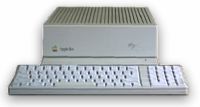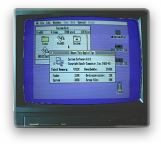
VintageWare > Apple
II > Apple IIGS
SCART cable
  
About the SCART Connector
The SCART connector was invented as a way to carry video, audio
and control signals between two video devices. It's most commonly
used to connect a video recorder or DVD player to a TV with a
single cable. The SCART connector is standard on most European
audio-visual equipment but is almost unknown in the USA. More
Info: Wikipedia entry for SCART.
RGB versus Composite Video
The Apple IIGS
can connect to a display using a composite video cable, but Apple
only intended this to be used for connecting a monochrome monitor.
For a colour display the RGB video output was normally used.
RGB stands for red, green and blue. This refers to the way the
video is sent as seperate colour signals. The SCART connector
on a TV allows for one type of connection which is not generally
found on non-SCART TVs, and that's an RGB video input.
Benefits for the Apple IIGS
There are two advantages to using
an RGB video connection over composite:
- better picture quality since there is no
need to convert from RGB to composite video in the computer and
back again in the TV
- you can use any colour system TV (PAL, SECAM
or NTSC) with your IIGS
whereas the computer's composite video only outputs in the NTSC
standard
While the picture quality will never be as
good as can be achieved with a true computer monitor, I have
found that on a cheap 48 cm (20") TV 80-column text is legible
and this size screen is great for games.
The rest of this page has details on making
a cable to connect an Apple IIGS to a SCART TV. If you would like one but don't want
to make your own I also sell them.
Cable
To make an RGB to SCART cable you
will need a length of shielded multiple-core cable, with at least
six cores - preferably more for sound and extra grounds. The
highest quality video cable uses 75-ohm coaxial cores for the
RGB video, medium quality cable uses shielded twisted pairs for
the video, and the cheapest cable just uses plain conductors
with an overall shield.
I have made cables using expensive coaxial
cable and cheap shielded cable, and in comparing them found no
difference in the picture quality. This is probably because the
cables are under two metres in length, and carrying fairly low
frequency video signals compared to the bandwidth required for
modern computer displays.
Connectors
For the Apple IIGS
end of the cable you will need a 15-pin sub-miniature D plug,
also known as a DA-15 male (don't buy a DE-15 plug, sometimes
called HD15, as this is the high-density version with three rows
of pins instead of two and is commonly used for VGA video connectors).
For the TV end you will need a SCART plug.
SCART Connector Signals
| Pin |
Function |
Signal Level |
Impedance |
| 1 |
audio out right |
0.5V RMS |
<1kΩ |
| 2 |
audio in right |
0.5V RMS |
>10kΩ |
| 3 |
audio out left |
0.5V RMS |
<1kΩ |
| 4 |
audio ground |
|
|
| 5 |
blue ground |
|
|
| 6 |
audio in left |
0.5V RMS |
>10kΩ |
| 7 |
blue video |
0.7V |
75Ω |
| 8 |
function select |
0V-2V=TV mode
5V-8V=wide screen
9.5V-12V=AV mode |
>10kΩ |
| 9 |
green ground |
|
|
| 10 |
data 2 |
|
|
| 11 |
green video |
0.7V |
75Ω |
| 12 |
data 1 |
|
|
| 13 |
red ground |
|
|
| 14 |
data ground |
|
|
| 15 |
red video |
0.7V |
75Ω |
| 16 |
RGB control |
0V-0.4V=composite
1V-3V=RGB |
75Ω |
| 17 |
video ground |
|
|
| 18 |
RGB control ground |
|
|
| 19 |
composite video out |
|
75Ω |
| 20 |
composite video in |
|
75Ω |
| 21 |
cable shield |
|
|
Apple IIGS Video Connector Signals
| Pin |
Function |
SCART Pin |
| 1 |
red ground |
13 |
| 2 |
red video |
15 |
| 3 |
composite sync |
20 |
| 4 |
no connection |
|
| 5 |
green video |
11 |
| 6 |
green ground |
9 |
| 7 |
-5 volts |
|
| 8 |
+12 volts |
8 via 1kΩ
16 via 270Ω |
| 9 |
blue video |
7 |
| 10 |
no connection |
|
| 11 |
sound |
2 and 6 |
| 12 |
composite video |
|
| 13 |
blue ground |
5 |
| 14 |
no connection |
|
| 15 |
no connection |
|
Wiring
Wire the plugs together using the
tables above. The red, green and blue video signals are connected
directly. If you are using twisted-pair or coaxial cable you
can match the RGB grounds together. Any extra conductors you
have in the cable can be used to connect the rest of the grounds
together, but all the pins marked ground will be connected together
inside the TV anyway. The composite sync from the IIGS is fed into the SCART composite
video input. The IIGS
sound should be fed into both the left and right audio inputs
unless you have a stereo decoder card in your IIGS in which case you could
wire up a seperate stereo plug.
The function select pin should be connected
to +12V so that when the IIGS is turned on the TV will automatically switch from
the tuner to the external input. I connect it via a 1kΩ
resistor to safeguard against accidentally shorting the +12V
output. Note that some TVs don't support this control line and
have to be manually switched to AV mode.
The RGB control needs between 1V and 3V to
switch from composite video mode to RGB mode. Connect it to the
+12V via a 270Ω resistor. This resistor combined with the
75Ω input drops the voltage to about 2.5V at the RGB control
pin.
The cable shield should be connected to the
metal surround of the SCART plug (the so-called pin 21) and to
the metal surround of the IIGS video plug.
Plug Backshell
The back of the Apple IIGS has a plastic layer over the metal panel through
which the video socket projects. Most D plug backshells grip
the plug with a plastic lip which curls over the front. The problem
is that most of these are too thick and will prevent the plug
from fitting into the IIGS properly. You may have to shop around to find one
that will fit, or else cut the projections off and glue the back
shell on.
Apple IIGS
Setup
When you use a IIGS
with a TV you may need to change the video frame frequency to
get a full sized or stable picture. To do so hold down the option
key while you turn on or reboot the computer and you will be
given a menu to set the video to 50 or 60 hertz. Normally you
need to set it to the same frequency as the TV standard you use,
i.e. 50 Hz for PAL or SECAM and 60 Hz for NTSC. Note that changing
this will also reset all your control panel settings to the default
values.
VintageWare > Apple II > Apple
IIGS SCART cable
|



